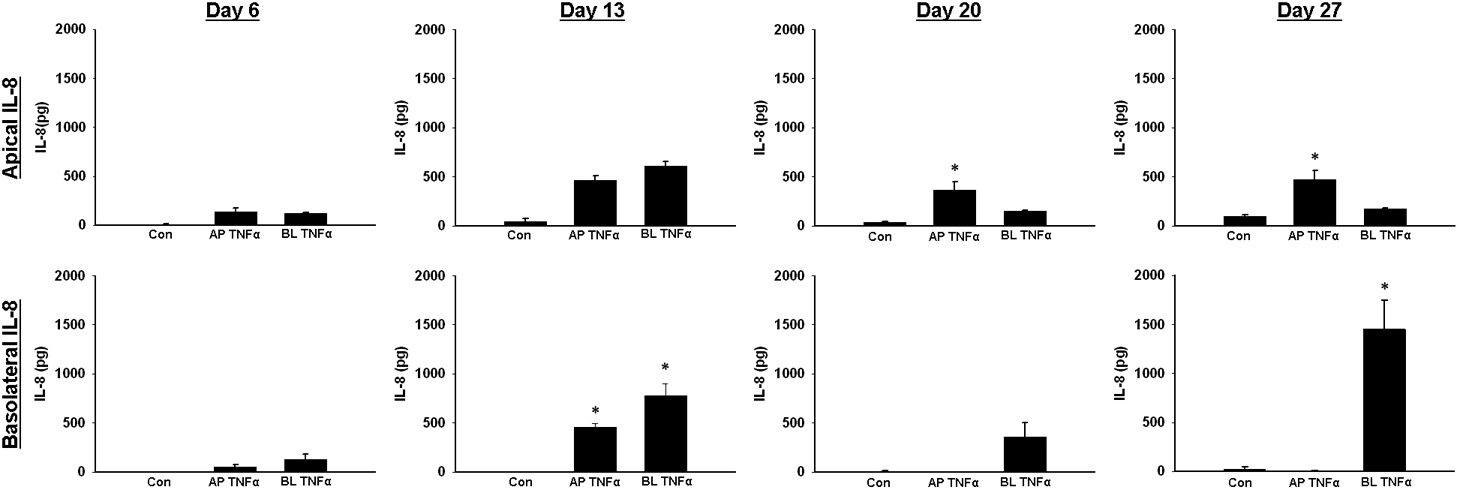TNF-α Induced Vectorial Secretion of IL-8 Corresponds to Development of Transepithelial Electrical Resistance in CACO-2 Cells
Dennis I. Sonnier*, Stephanie R. Bailey, Timothy a. Pritts, Alex B. Lentsch
Dept. of Surgery, University of Cincinnati, Cincinnati, OH
The intestinal epithelium, a vital part of the innate immune system, provides a physical barrier between gut lumen and lamina propria and plays an active role in the inflammatory response. Previously, we found that polarized intestinal epithelial cells respond to an inflammatory stimulus in a directional, vectorial manner, with secretion of IL-8 directed toward the inflammatory stimulus. Under specific conditions, cellular differentiation in vitro mirrors the in vivo process, where the cell matures into a columnar, polarized epithelial cell with distinct apical and basolateral regions. Transepithelial electrical resistance (TEER) is used to detect formation of tight junctions and as a measure of apical to basolateral polarity. The relationship of TEER to cellular processes such as brush border enzyme transport, nutrient receptors and barrier function is well described, the relationship between TEER and the intestinal epithelial cell’s inflammatory polarity is unknown. We hypothesized that increased TEER corresponds with the intestinal epithelial cell’s ability to respond to an inflammatory signal in a vectorial manner.Methods: The Caco-2 cell, a transformed colon cancer cell line, exhibits characteristics of intestinal epithelial cells in culture. Cells were plated on Transwell filters for up to 32 days. At intervals, groups of cells (n=3) were treated with TNF-α (100ng/ml) or serum free media in the apical or basolateral chamber. After 24 hours, production of the chemokine IL-8 was determined in apical and basolateral media by ELISA. Electrical resistance was measured immediately prior to treatment and TEER was calculated by multiplying the resistance times the area of the monolayer.Results: TEER increased slowly from day of plating until day 13. TEER increased markedly between days 13 and 18, to a peak level above 2000Ωcm2 and maintained a level of 1500Ωcm2 or greater for the remainder of the experiment. Prior to the increase in resistance, treatment of apical or basolateral chambers with TNF-α resulted in equal apical and basolateral secretion of IL-8. After the TEER increase, as on day 20, apical TNF-α treatment resulted in only apical IL-8 secretion while basolateral stimulation results in both apical and basolateral IL-8 secretion. Subsequent apical or basolateral treatments, as on day 27, maintained this vectorial secretion pattern, but with a significant increase in the magnitude of basolateral secretion.Conclusions: In the present study, the ability of intestinal epithelial cells to respond to inflammatory stimuli in a vectorial manner correlated with an increase in TEER. These findings are important because they suggest the importance of cell polarity in the development of the intestinal epithelial cell’s mature inflammatory phenotype.
Figure 1. Time course of transepithelial electrical resistance in Caco-2 cells. Resistance values were measured twice weekly after plating. TEER was calculated by multiplying the resistance(Ω) by the area of the membrane (4.5cm2). Note the marked increase in TEER between days 13 and 18.
Figure 2. Development of TNF-α induced vectorial secretion of IL-8 in Caco-2 cells. IL-8 production was measured after interval apical or basolateral TNF-α treatment (100ng/ml). Control cells were treated with serum free media. *p<0.05 vs. other groups by ANOVA and SNK post hoc test.
Back to 2011 Program



